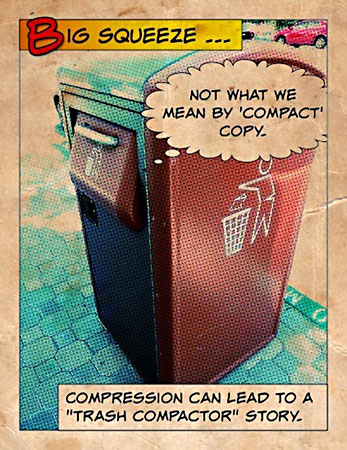Polish your message to make it short and sweet
Too often, we cut our copy the hard way: a word at a time. If we need to cut 600 words, we peer through our prose until we find a candidate for cutting.
There’s one, we say. There’s one. There’s one.

The rest of our lives later, we’ve cut our copy by 600 words. But now we have a piece that’s, while shorter, flat and lifeless. Elmore Leonard used to famously say:
I like to leave out the parts people skip.
But with compression — polishing your piece a word at a time — we tend to take out the parts people read.
That’s because the first thing to go when you’re cutting a word at a time is the anecdotes. That’ll save 50 words. Then the metaphors. That’s 40.
We want to write pieces that are an inch wide and a mile deep. We want to cover very little ground, but cover it fully. That’s why tightening your story angle is so important. You don’t have room in your blog post to cover a card catalog of information.
So here are three ways to make polishing, or compression, work for you.
1. Avoid the trash compactor story.
At its worst, compression — polishing your piece a word at a time — can lead to a trash compactor story.

“Most writers, when ordered to write short, make the mistake of writing the garbage compactor story, compressing everything in the notebook into a hard, indigestible pellet of news.”
— Donald M. Murray, Pulitzer Prize-winning journalist and author of Writing to Deadline
Don’t squeeze the life out of your piece. Sometimes, compression works about as well as Microsoft Word’s AutoSummarize function. Here’s what happens to, say, the Gettysburg Address when you click AutoSummarize:
Now we are engaged in a great civil war, testing whether that nation, or any nation so conceived and so dedicated, can long endure.
Yup, it’s short. But you’ve got to admit, it loses something in translation.
2. Cut first, polish second.
The solution to the trash compactor story? Cut first, polish second.
You don’t want to polish something in half. What if jewelers took polishing cloths to raw stones? That’s not an efficient way to, say, get an emerald cut, and the results would probably be fairly disappointing. But pull out that polishing cloth after you cut the emerald into shape, and now you can make your jewel shiny and bright.
Same thing’s true with polishing your message. Cut first — tightening your story angle and breaking your message up — to get the copy into shape. Then, when you’re about 10% above your word count limit, polish the rest.
The result: tight, bright copy.
3. Edit with a highlighter.
When I conduct writing workshops at Tellabs, I always learn as much as I teach.
One day, watching the Tellabs team edit a press release during a practice session, I was surprised to see George Stenitzer, vice president of corporate communications, wielding a highlighter instead of a pencil. Instead of cutting words, phrases and ideas he wanted to remove from the piece, George was highlighting information he wanted to keep.

It’s a great technique, because it focuses you on finding what you need instead of what you want to scrap. Think of it as Marie Kondo-ing your message: Instead of leaving all of your clothes in your closet and auditioning which should go out, take everything out of your closet and audition each garment to get back into your closet.
Forget Strunk and White: Instead of omitting needless words, identify needed words.
“I use a highlighter to pluck a simple message from a sea of complexity.”
— George Stenitzer, vice president of corporate communications, Tellabs
Having stolen George’s technique, I’ve come to believe that highlighting needed words is more effective than omitting needless words. It gets you there faster.
I think it will work for you, too.
(See how artist Austin Kleon writes with an eraser — or, in his case, a black marker.)
Learn more
Remember, corporate communications writing isn’t academic writing or business writing. Here’s how to handle your:
- Wordy sentences: How to remove every extra word
- Passive sentences: How to turn passive voice into active voice
- Sentence structure: How to write with the fewest words
- Writing process: When to get rid of unnecessary words

Leave a Reply